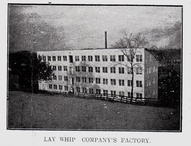The Lay Whip Factory
Sherbrooke Daily Record
- « The Village of Rock Island », Supplement of the S. D. R., 17 décembre 1901, 4 p.
- La « Lay Whip Company factory » est fondée en septembre 1890, en tant que branche de la Lay Whip Company de Westfield (Mass.), mais est aujourd’hui complètement indépendante. La production s’est d’abord faite dans le « Old Libby building », puis à l’étage supérieur de la Butterfield jusqu’en octobre 1901 « …when the large new factory on the south bank of the Tomifobia river, but entirely within the municipality of Rock Island, was opened ». On souligne qu’il s’agit de la plus grande fabrique du genre au Canada et qu’on y emploie une quarantaine de travailleurs en plus de huit agents sur la route, sous la direction de T. J. Norris et la propriété de E. R. Lay.
Centenaire de Rock Island
- p. 3-4
- Lay Whip factory
- Started in the old Libby building, then moved on the upper floor of the old Butterfield factory until 1901 when new factory was built on the bank of the river.
- Largest whip factory in Canada
- Employed 48 people
- Produce 2000 whip a day
- The building was destroyed by fire in 1988.
Stanstead College Magazine
- Bertha Tiffin, “The Manufactures of Rock Island”, Vol. XVIII, No. 2, Feb. 1920, p. 10.
- The Lay Whip Factory […] the machinery in this factory is run by electricity.
Stanstead Journal
- Feb. 23, 1933: “Talks on Local Industries”
- The Whip industry
- Whip-making through cutting strands from horsehides by stripping.
- Boiling whips in different oils was a step forward in the evolution of whip-making.
- Plaiting was first done by hand, then using a revolving barrel to carry the threads around the whip and weave them together.
- Rattan, used in the manufacture of whips comes from Singapore.
- Whalebone was once an all important factor in the manufacture of whips, but in recent years rawhide had taken its place, as the latter was unaffected by climate conditions and would not snap off under severe use in low temperatures.
- The India buffalo furnished one of the best materials for rawhide.
- Lay Whip Co. founded by E. R. Lay and T. J. Norris.
- 1910 was a peak year for production reaching bte 75 and 100 thousands whips
- Once supplied the RCMP.
Documents visuels
 Lay Whip Factory (1901), Supplement from Sherbrooke Daily Record, 17 décembre 1901, p. 2.
Lay Whip Factory (1901), Supplement from Sherbrooke Daily Record, 17 décembre 1901, p. 2.  Lay Whip Factory, dans Stanstead Historical Society Journal, vol. 13, 1989, p. 105.
Lay Whip Factory, dans Stanstead Historical Society Journal, vol. 13, 1989, p. 105.  La Lay Whip Factory incendiée. DEMANDER AUTORISATION SOCIÉTÉ D'HISTOIRE DE SHERBROOKE POUR DIFFUSION. Numérisation d'une photocopie
La Lay Whip Factory incendiée. DEMANDER AUTORISATION SOCIÉTÉ D'HISTOIRE DE SHERBROOKE POUR DIFFUSION. Numérisation d'une photocopie


